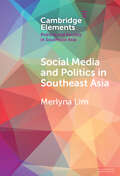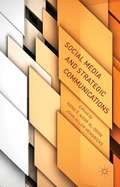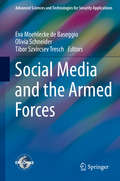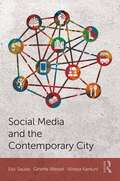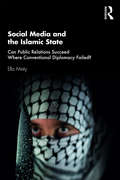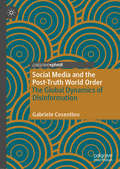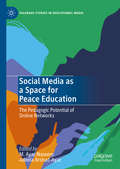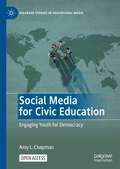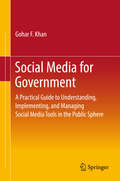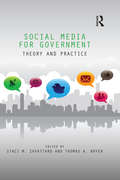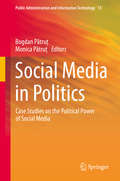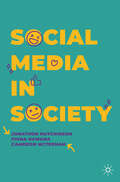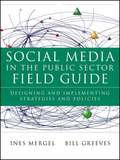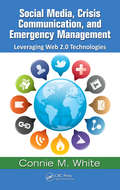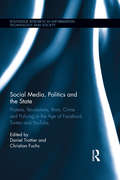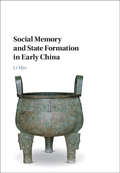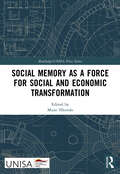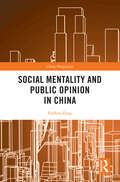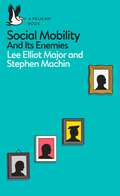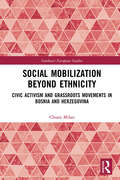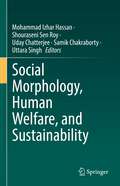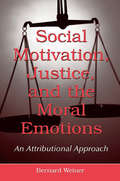- Table View
- List View
Social Media and Politics in Southeast Asia (Elements in Politics and Society in Southeast Asia)
by Merlyna LimThis Element endeavors to enrich and broaden Southeast Asian research by exploring the intricate interplay between social media and politics. Employing an interdisciplinary approach and grounded in extensive longitudinal research, the study uncovers nuanced political implications, highlighting the platform's dual role in both fostering grassroots activism and enabling autocratic practices of algorithmic politics, notably in electoral politics. It underscores social media's alignment with communicative capitalism, where algorithmic marketing culture overshadows public discourse, and perpetuates affective binary mobilization that benefits both progressive and regressive grassroots activism. It can facilitate oppositional forces but is susceptible to authoritarian capture. The rise of algorithmic politics also exacerbates polarization through algorithmic enclaves and escalates disinformation, furthering autocraticizing trends. Beyond Southeast Asia, the Element provides analytical and conceptual frameworks to comprehend the mutual algorithmic/political dynamics amidst the contestation between progressive forces and the autocratic shaping of technological platforms.
Social Media and Strategic Communications
by John Allen Hendricks Hana S. Noor Al-DeenSocial Media and Strategic Communications provides truly comprehensive and original scholarly research that exhibits the strategic implementation of social media in both advertising and public relations.
Social Media and the Armed Forces (Advanced Sciences and Technologies for Security Applications)
by Eva Moehlecke de Baseggio Olivia Schneider Tibor Szvircsev TreschSocial media has fundamentally changed communication and interaction in today's society. Apart from being used by individuals, it is also omnipresent in public sector organisations such as the armed forces. This book examines the opportunities and risks associated with social media in the context of the armed forces from an international, social scientific perspective. It discuses the impact of social media in the everyday life of military personnel and analyses the extent to which social media influences their performance, be it as a distraction or as a source of perceived appreciation. It particularly highlights the representation of masculinity and femininity in military social media channels, since the way gender is portrayed on social media has an effect on how future recruits and – at the other end of the military career spectrum – veterans feel they are approached. The book also focuses on the new form of follow-up discussion, which enables the armed forces to interact with the population. On social media, the armed forces are publicly presented, and this shapes the public’s opinions on them. Further, the armed forces can use debates as a monitoring tool of society's attitudes towards them or towards events that have an effect on society. Conversely, social media can lend a voice to military personnel, allowing them to be publicly heard. As discussions on social media can only be controlled to a limited extent, the context in which the armed forces are discussed alters their sphere of influence and potentially leads to a loss of control. An extreme example of this is the use of social media as a tool to strategically distribute misinformation in order to shape public opinion and threaten national security. Moreover, the use of social media to demoralise adversaries or to harm their credibility results in social media being considered a cyber weapon that affects politics and military activities.
Social Media and the Contemporary City
by Eric Sauda Ginette Wessel Alireza KarduniThe widespread adoption of smartphones has led to an explosion of mobile social media data, more than a billion messages per day that continuously track location, content, and time. Social Media in the Contemporary City focuses on the effects of social media on local communities and urban space in a variety of political and economic settings related to social activism, informal economic activity, public art, and global extremism. The book covers events ranging from Banksy art installations, mobile food trucks, and underground restaurants, to a Black Lives Matter protest, the Christchurch mosque shootings, and the Pulse nightclub shooting. The interplay between urban space, local community, and social media in each case study requires diverse methodologies that are both computational (i.e. machine learning, social network analysis, and natural language processing) and ethnographic (i.e. semi-structured interviews, thematic analysis, and site analysis). The book views social media not as a replacement for the local community or urban space but rather as a translation of the uses and meanings of all three realms. The book will be of interest to students, researchers, and instructors in a number of disciplines including urban design/planning, media studies, geography, and communications.
Social Media and the Islamic State: Can Public Relations Succeed Where Conventional Diplomacy Failed?
by Ella MintyThis book examines how social media has transformed extremist discourse. Drawing on ISIS and their sophisticated use of social media platforms and PR concepts, it explores the ways in which the outfit was able to recruit, mobilise and spread fundamentalist propaganda in regions where it had little physical presence. One of the first studies to draw a link between international diplomacy, the rise of fundamentalism and public relations, this book will be of great interest to scholars and researchers of defence and strategic studies, especially those working on ISIS propaganda, Middle East Studies, media studies, digital humanities, communication studies, public relations and international relations, as well general readers.
Social Media and the Post-Truth World Order: The Global Dynamics of Disinformation
by Gabriele CosentinoThis book discusses post-truth not merely as a Western issue, but as a problematic political and cultural condition with global ramifications. By locating the roots of the phenomenon in the trust crisis suffered by liberal democracy and its institutions, the book argues that post-truth serves as a space for ideological conflicts and geopolitical power struggles that are reshaping the world order. The era of post-truth politics is thus here to stay, and its reach is increasingly global: Russian trolls organizing events on social media attended by thousands of unaware American citizens; Turkish pro-government activists amplifying on Twitter conspiracy theories concocted via Internet imageboards by online subcultures in the United States; American and European social media users spreading fictional political narratives in support of the Syrian regime; and Facebook offering a platform for a harassment campaign by Buddhist ultra-nationalists in Myanmar that led to the killing of thousands of Muslims. These are just some of the examples that demonstrate the dangerous effects of the Internet-driven global diffusion of disinformation and misinformation. Grounded on a theoretical framework yet written in an engaging and accessible way, this timely book is a valuable resource for students, researchers, policymakers and citizens concerned with the impact of social media on politics.
Social Media and the Public Interest: Media Regulation in the Disinformation Age
by Philip M. NapoliFacebook, a platform created by undergraduates in a Harvard dorm room, has transformed the ways millions of people consume news, understand the world, and participate in the political process. Despite taking on many of journalism’s traditional roles, Facebook and other platforms, such as Twitter and Google, have presented themselves as tech companies—and therefore not subject to the same regulations and ethical codes as conventional media organizations. Challenging such superficial distinctions, Philip M. Napoli offers a timely and persuasive case for understanding and governing social media as news media, with a fundamental obligation to serve the public interest.Social Media and the Public Interest explores how and why social media platforms became so central to news consumption and distribution as they met many of the challenges of finding information—and audiences—online. Napoli illustrates the implications of a system in which coders and engineers drive out journalists and editors as the gatekeepers who determine media content. He argues that a social media–driven news ecosystem represents a case of market failure in what he calls the algorithmic marketplace of ideas. To respond, we need to rethink fundamental elements of media governance based on a revitalized concept of the public interest. A compelling examination of the intersection of social media and journalism, Social Media and the Public Interest offers valuable insights for the democratic governance of today’s most influential shapers of news.
Social Media as a Space for Peace Education: The Pedagogic Potential of Online Networks (Palgrave Studies in Educational Media)
by M. Ayaz Naseem Adeela Arshad-AyazThis book explores the potential of social media as a space for teaching and bringing about sustainable peace. Using cutting-edge research, the editors and authors analyze the fundamental transformations taking place in the digital and interactive public sphere, most recently with the advent of the ‘post-truth’ age and the impact of this upon young people’s perceptions of ‘friend’ and ‘foe’. Peace initiatives at almost every level recognize the importance of education for sustainable peace: this volume examines the opportunities emerging from these societal transformations for both formal and informal education. This book will appeal to students and scholars of social media, peace education and the post-truth age.
Social Media for Civic Education: Engaging Youth for Democracy (Palgrave Studies in Educational Media)
by Amy L. ChapmanThis open access book provides the theoretical and pedagogical foundations for a promising new approach to civic education: using social media to teach civics. While many measures indicate that youth civic engagement has long been in decline, many of these measures fail to take into account all of the ways that youth can interact with civic life. One of these understudied ways is through social media, including platforms like Twitter, where young people have the opportunity to encounter the news, engage with people in power, and bring attention to the needs in their community. Throughout this volume, Chapman explores how and why teachers can use social media to teach civics, as well as how it might meet the needs of students in ways other approaches do not.
Social Media for Government
by Gohar F. KhanThis book provides practical know-how on understanding, implementing, and managing main stream social media tools (e. g. , blogs and micro-blogs, social network sites, and content communities) from a public sector perspective. Through social media, government organizations can inform citizens, promote their services, seek public views and feedback, and monitor satisfaction with the services they offer so as to improve their quality. Given the exponential growth of social media in contemporary society, it has become an essential tool for communication, content sharing, and collaboration. This growth and these tools also present an unparalleled opportunity to implement a transparent, open, and collaborative government. However, many government organization, particularly those in the developing world, are still somewhat reluctant to leverage social media, as it requires significant policy and governance changes, as well as specific know-how, skills and resources to plan, implement and manage social media tools. As a result, governments around the world ignore or mishandle the opportunities and threats presented by social media. To help policy makers and governments implement a social media driven government, this book provides guidance in developing an effective social media policy and strategy. It also addresses issues such as those related to security and privacy.
Social Media for Government: Theory and Practice
by Staci M. Zavattaro Thomas A. BryerSocial media is playing a growing role within public administration, and with it, there is an increasing need to understand the connection between social media research and what actually takes place in government agencies. Most of the existing books on the topic are scholarly in nature, often leaving out the vital theory-practice connection. This book joins theory with practice within the public sector, and explains how the effectiveness of social media can be maximized. The chapters are written by leading practitioners and span topics like how to manage employee use of social media sites, how emergency managers reach the public during a crisis situation, applying public record management methods to social media efforts, how to create a social media brand, how social media can help meet government objectives such as transparency while juggling privacy laws, and much more. For each topic, a collection of practitioner insights regarding the best practices and tools they have discovered are included. Social Media for Government responds to calls within the overall public administration discipline to enhance the theory-practice connection, giving practitioners space to tell academics what is happening in the field in order to encourage further meaningful research into social media use within government.
Social Media in Politics
by Bogdan Pătruţ Monica PătruţThis volume sets out to analyse the relation between social media and politics by investigating the power of the internet and more specifically social media, in the political and social discourse. The volume collects original research on the use of social media in political campaigns, electoral marketing, riots and social revolutions, presenting a range of case studies from across the world as well as theoretical and methodological contributions. Examples that explore the use of social media in electoral campaigns include, for instance, studies on the use of Face book in the 2012 US presidential campaign and in the 2011 Turkish general elections. The final section of the book debates the usage of Twitter and other Web 2. 0 tools in mobilizing people for riots and revolutions, presenting and analysing recent events in Istanbul and Egypt, among others.
Social Media in Society
by Jonathon Hutchinson Fiona Suwana Cameron McTernanThis book is about the role that social media plays in the lives of individuals, societies, economies and polities. It therefore takes in a wide view of the emergent and changing impacts of social media platforms, and social media practices. As a consequence, it examines social media use through various intellectual and scholarly traditions --psychology, sociology, cultural studies, economics, and (national and global) politics – but it is primarily situated in the field of media and communications studies. As such, it frames its analysis of social media impacts using media studies concepts and terminology, and places media texts, forms, industries and agents (producers, audiences and other users) at the centre of each thematic chapter.
Social Media in the Public Sector Field Guide
by Ines Mergel Bill GreevesStocked with real-life examples and case studies, this book explores myriad social media tools and provides step-by-step guidance on how to implement them based on mission, goals, and strategy. Written in a jargon-free and accessible style, the book is a go-to resource for anyone in government who wants to put the power of social media to work for their organization.Praise for Social Media in the Public Sector Field Guide"Twitter and Facebook and Blogs, Oh My! In this bewildering new field of social media, Mergel and Greeves expertly provide practical advice for governments to harness the power of these new online services."-Bill Schrier, deputy director, Center for Digital Government, eRepublic.com; former CTO (CIO), City of Seattle"This is simply a must-read book for anyone interested in or involved with social media in the public sector. The authors take a refreshing and original approach supported by excellent examples regarding the evolving role social media is playing and can play in government. I cannot think of two better experienced authors to help guide us through the new realities of social media in government."-Dr. Alan R. Shark, executive director, Public Technology Institute; assistant professor, Rutgers University School of Public Affairs and Administration"In the local government sector there seem to be three schools of thought regarding social media: I've got a Facebook page-let's jump right in!, Not happening on my watch!, and Who cares? This field guide is perfect for any of the above, as it provides practical applications and rationale for why local government needs to connect with people where they are-which is on the Internet. Our association of nearly 500 innovative local governments knows that Mergel and Greeves are the perfect authors for this must-have tutorial."-Karen Thoreson, president and chief operating officer, Alliance for Innovation"Every day on GovLoop.com, our network of 60,000 government leaders share best practices and ask questions about using social media in government. I've often been asked by members for a good reference to help them get going on their federal, state, or local government social media programs. I never had an answer-now I do: This field guide is the go-to resource to ensure your social media programs deliver real mission results. Mergel and Greeves are experts in the field-a blend of research and real-world experience to get you to where you need to go."-Steve Ressler, founder and president, GovLoop.com
Social Media, Crisis Communication, and Emergency Management: Leveraging Web 2.0 Technologies
by Connie M. WhiteAlthough recent global disasters have clearly demonstrated the power of social media to communicate critical information in real-time, its true potential has yet to be unleashed. Social Media, Crisis Communication, and Emergency Management: Leveraging Web 2.0 Technologies teaches emergency management professionals how to use social media to improve
Social Media, Politics and the State: Protests, Revolutions, Riots, Crime and Policing in the Age of Facebook, Twitter and YouTube (Routledge Research in Information Technology and Society #16)
by Christian Fuchs Daniel TrottierThis book is the essential guide for understanding how state power and politics are contested and exercised on social media. It brings together contributions by social media scholars who explore the connection of social media with revolutions, uprising, protests, power and counter-power, hacktivism, the state, policing and surveillance. It shows how collective action and state power are related and conflict as two dialectical sides of social media power, and how power and counter-power are distributed in this dialectic. Theoretically focused and empirically rigorous research considers the two-sided contradictory nature of power in relation to social media and politics. Chapters cover social media in the context of phenomena such as contemporary revolutions in Egypt and other countries, populism 2.0, anti-austerity protests, the fascist movement in Greece's crisis, Anonymous and police surveillance.
Social Memory and State Formation in Early China
by Min LiIn this book, Li Min proposes a new paradigm for the foundation and emergence of the classical tradition in early China, from the late Neolithic through the Zhou period. <P><P>Using a wide range of historical and archaeological data, he explains the development of ritual authority and particular concepts of kingship over time in relation to social memory. His volume weaves together the major benchmarks in the emergence of the classical tradition, particularly how legacies of prehistoric interregional interactions, state formation, urban florescence and collapse during the late third and the second millenniums BCE laid the critical foundation for the Sandai notion of history among Zhou elite. Moreover, the literary-historical accounts of the legendary Xia Dynasty in early China reveal a cultural construction involving social memories of the past and subsequent political elaborations in various phases of history. This volume enables a new understanding on the long-term processes that enabled a classical civilization in China to take shape.<P> Proposes a new paradigm on the foundation and emergence of the classical tradition in early China.<P> Proposes a new perspective on the social memory and state formation as two cornerstones of social developments in early China.<P> Employs a wide range of historical and archaeological data in order to explain the development of ritual authority and particular concepts of kingship over time in relation to social memory.<P>
Social Memory as a Force for Social and Economic Transformation (Routledge/UNISA Press Series)
by Muxe NkondoThis volume of essays is a reflection on social memory as a force for social and economic transformation. Written by scholars and organic intellectuals, it focuses on the uses of social memory, in particular the conflict between the legacies of colonialism and the movement for fundamental change. The content addresses both experts and ordinary citizens alike, with a view to advancing discourse on where we are right now, and how we move on from here to achieve meaningful transformation. As scholars and public representatives with a deep understanding of the social, economic and political dynamics of modern history of South Africa, the contributors offer their unique perspectives and reflections on history, politics, economics, culture, education, ethics and the arts, as well as the links that bind these aspects into an ecology of ideas and attitudes.
Social Mentality and Public Opinion in China (China Perspectives)
by Fanbin ZengThis book explores the relationship between social mentality, public opinion, media, and other factors through mixed methods in China, especially since the 21st century.The book deploys qualitative and quantitative research and adopts a multi-disciplinary perspective and diversified research methods. The studies are built on and contribute to the burgeoning literature seeking to anatomize the relationship between social mentality, media, and public opinion from the point of view of sociology and communication. It also aims to explore how media can be used to appease public opinion. As the first systematic study of the interconnection between social mentality and public opinion, this book provides empirical support and a theoretical framework for both areas. It will thus be a great read for students and scholars of communication, sociology, and social psychology, especially for those with a focus on China and new media.
Social Mobility: And Its Enemies (Pelican Books)
by Stephen Machin Lee Elliot MajorWhat are the effects of decreasing social mobility?How does education help - and hinder - us in improving our life chances?Why are so many of us stuck on the same social rung as our parents? Apart from the USA, Britain has the lowest social mobility in the Western world. The lack of movement in who gets where in society - particularly when people are stuck at the bottom and the top - costs the nation dear, both in terms of the unfulfilled talents of those left behind and an increasingly detached elite, disinterested in improvements that benefit the rest of society.This book analyses cutting-edge research into how social mobility has changed in Britain over the years, the shifting role of schools and universities in creating a fairer future, and the key to what makes some countries and regions so much richer in opportunities, bringing a clearer understanding of what works and how we can better shape our future.
Social Mobilization Beyond Ethnicity: Civic Activism and Grassroots Movements in Bosnia and Herzegovina (Southeast European Studies)
by Chiara MilanThis book offers an in-depth investigation of the emergence and spread of social mobilizations that transcend ethnicity in societies violently divided along ethno-national lines. Using Bosnia Herzegovina as a case study, the book explores episodes of mobilization which have superseded ethno-nationalist cleavages. Bosnia Herzegovina emerged from the 1992–95 war brutally impoverished and deeply ethnically divided, representing a critical and strategic case for the examination and understanding of the dynamics of mobilization in such divided societies. Despite difficult circumstances for civic-based collective action, social mobilizations in the country have grown in size, number and intensity in recent years. Marked by citizen demand for accountable governance, responsive urbanism, and access to basic human rights, these protests have been driven by economic, social and political problems which cut across religious and ethnic divides. Examining the variation in spatial and social scale of contention, the book investigates movements’ formation, their organizational structures and networking strategies and advances research on divided societies and social movements. This volume will be of interest to scholars and researchers of Southeastern Europe and those examining political dissent, social movements and mobilization in divided societies, as well as practitioners in civil society, grassroots groups and political activists.
Social Morphogenesis
by Margaret S. ArcherThe rate of social change has speeded up in the last three decades, but how do we explain this? This volume ventures what the generative mechanism is that produces such rapid change and discusses how this differs from late Modernity. Contributors examine if an intensification of morphogenesis (positive feedback that results in a change in social form) and a corresponding reduction in morphostasis (negative feedback that restores or reproduces the form of the social order) best captures the process involved. This volume resists proclaiming a new social formation as so many books written by empiricists have done by extrapolating from empirical data. Until we can convincingly demonstrate that a new generative mechanism is at work, it is premature to argue what accounts for the global changes that are taking place and where they will lead. More concisely we seek to answer the question whether or not current social change can be regarded as social morphogenesis. Only then, in the next volumes will the same team of authors be able to remove the question mark.
Social Morphology, Human Welfare, and Sustainability
by Shouraseni Sen Roy Mohammad Izhar Hassan Uday Chatterjee Samik Chakraborty Uttara SinghThis volume discusses a broad range of human welfare problems associated with and stemming from social issues, natural resource deficiencies, environmental hazards, vulnerability to climate change, and sustainability challenges. The chapters form a framework centered around the concept of social morphology, i.e. the role of humans in shaping society, and associated human-nature interactions which inform the ability to achieve sustainable welfare and well-being. The book is divided in six sections. Section I contains the introductory chapters where the book explores shifting interfaces between environment, society, and sustainability outcomes. Section II discusses contemporary issues of social welfare, and covers sustainable approaches in geo-heritage and ecotourism. Section III addresses the roots of various social conflicts and inequalities in relation to overpopulation, poverty, illiteracy, employment concerns, and human migration. Section IV highlights social security and areas of social deprivation, including urban affordability, gender equality, and women’s health. Section V covers social issues resulting from natural hazards and disasters. Section VI concludes the book with a discussion of the way forward for social sustainability. The book will be of interest to students, researchers, policy makers, environmentalists, NGOs, and social scientists.
Social Motivation, Justice, and the Moral Emotions: An Attributional Approach
by Bernard WeinerSocial Motivation, Justice, and the Moral Emotions proposes an attribution theory of interpersonal or social motivation that distinguishes between the role of thinking and feeling in determining action. The place of this theory within the larger fields of motivation and attributional analyses is explored. It features new thoughts concerning social motivation on such topics as help giving, aggression, achievement evaluation, compliance to commit a transgression, as well as new contributions to the understanding of social justice. Included also is material on moral emotions, with discussions of admiration, contempt, envy, gratitude, and other affects not considered in Professor Weiner's prior work. The text also contains previously unexamined topics regarding social inferences of arrogance and modesty.Divided into five chapters, this book:*considers the logical development and structure of a proposed theory of social motivation and justice;*reviews meta-analytic tests of the theory within the contexts of help giving and aggression and examines issues related to cultural and individual differences; *focuses on moral emotions including an analysis of admiration, envy, gratitude, jealousy, scorn, and others;*discusses conditions where reward decreases motivation while punishment augments strivings; and*provides applications that are beneficial in the classroom, in therapy, and in training programs.This book appeals to practicing and research psychologists and advanced students in social, educational, personality, political/legal, health, and clinical psychology. It will also serve as a supplement in courses on motivational psychology, emotion and motivation, altruism and/or pro-social behavior, aggression, social judgment, and morality. Also included is the raw material for 13 experiments relating to core predictions of the proposed attribution theory.
Social Movement Campaigns on EU Policy (International Political Economy Series)
by Louisa ParksThis book investigates if and how social movement campaigns influence European policy, a particularly pertinent question in today's political climate of disillusionment with Europe in many member states. Using a range of campaigns launched by social movement organisations, from genetically modified organisms and Internet freedom to trade union rights and water rights, Parks elucidates the important differences between technical and political campaigns. Technical campaigns are characterised by extended engagement with consultation mechanisms and the production of expert information, particularly for the European Commission. In political campaigns, social movement organisations target the EU at national and local levels, using strategies reminiscent of social movements as they are more commonly known. A comparison of the campaigns suggests that targeting member state governments with protest and harnessing public opinion is central to securing influence over EU policy, and that where national and local levels are made integral to efforts in shaping European policy, influence is more likely.
